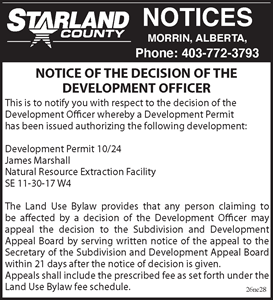
A ribbon cutting was held on Friday afternoon to celebrate over three years work and millions of dollars in upgrading both the Drumheller Municipal Landfill and the Waste Water Treatment Facility.
The federal, provincial, and municipal governments split the $7.8 million bill in thirds at $2.6 million each.
MP Kevin Sorenson and MLA Strathmore-Brooks Arno Doerksen attended the ribbon cutting ceremony and luncheon to represent Canada’s and Alberta’s contribution to the projects.
“When we look in past we see many dollars go into the urban centres, and still do today. But here today, we see dollars go into a project outside of Calgary or Red Deer and into the rural areas,” said Sorenson. “This will benefit residents in the long term.”
“There are many, many reasons why it benefitted us to get the money. It’s going to save the tax payers dollars in the long term. Overall, it’s so much better for our association, our region, and our taxpayers. We have a state of the art facility now,” says operations manager for Drumheller and District Solid Waste Management Association Tammi Nygaard.
The clay layer prevents waste from leaking into earth, the leachate system diverts leachate (liquid formed by decomposed garbage) and disposes of it in an environmentally safe way. The scale house was also expanded with an outbound scale and updated computer system. Now there is not as long a wait when going through the landfill.
The million dollar recycling facility is a new building that will see newsprint and cardboard from 60 regional program members in the area.
“Our new building couldn’t handle it,” says Nygaard, adding three years ago they were recycling 40 metric tonnes, and now do 80 metric tonnes. “Our cardboard alone has jumped as far as participation and how many people are involved. As this grows we want to be able to collect other recyclables like tin and plastic.”
The Waste Water Treatment Plant has nearly seen the completion of four years of work: two secondary clarifiers added, upgrading of aeration system, new headworks building, new pumphouse for secondary clarifiers, and the equalization pond has been lined with concrete. Total cost for the project was over $16 million. Funds came from town reserves and other funding sources.
“It helps us meet the regulatory requirements, easier to achieve standards in the future. There is some flexibility built into the operation, which allows us leeway in the operation side of it,” says Director of Infrastructure Allan Kendrick.
The plant was built in 1975, retrofitted and upgraded since then, but was in need of repairs before this project.
Kendrick believes this should extend the lifetime of the Waste Water Treatment Facility by 25 years.




























